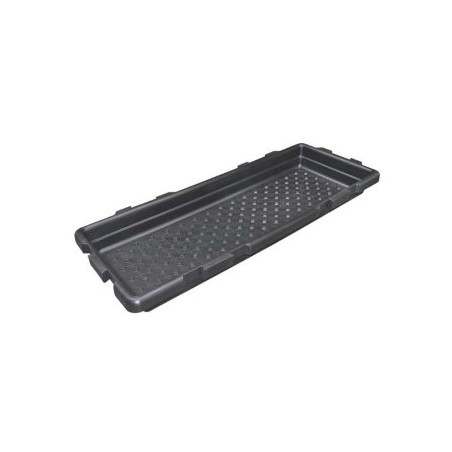Description of the herd
The clinical case took place in a 320-sow farrow-to-finish French farm in Brittany. The herd was positive to PRRSV and Mycoplasma hyopneumoniae, and was negative to Actinobacillus pleuropneumoniae and atrophic rhinitis.

The farmers self-produce their gilts (LW x LD) and their compound feed, and buy commercial semen (Pietrain boars).
Gilts and sows were vaccinated against PRRS (MLV vaccine), parvovirus, erysipelas and swine influenza (bivalent vaccine). Piglets were vaccinated with a one-shot mycoplasma vaccine at weaning.
The age at weaning was 28 days and farrowings occurred every 3 weeks (7 batches management system).
The performance of the breeding herd and the growing pigs was excellent up to mid 2010 (Tables 1 and 2).
Table 1: Technical results of the breeding herd (before the outbreak) compared to the reference results in Brittany.
| Herd in 2009 | Top 10 % in Brittany 2009 | |
| Weaned/prod. sow/year | 30,4 | 31,3 |
| Total born | 14,31 | 14,7 |
| Weaned/litter | 12,31 | 12,3 |
| % losses in suckling piglets | 9,2 % | 10,6 % |
| % born dead | 5,3 % | 6 % |
| Conception rate | 89,5 % | 93,2 % |
Table 2: Technical results of the growing pigs( before the outbreak) compared to the reference results in Brittany.
| Herd in 2009 | Top 10 % in Brittany 2009 | |
| Pigs produced/sow | 24,8 | 24,5 |
| Global FC ratio | 2,75 | 2,8 |
| % losses from weaning to slaughter | 5,9 % | 4,6 % |
| Daily gain 30-115 kg | 785 g | 794 g |
According to the clinical signs and the serological profiles (all the pigs were tested serologically negative at the end of the fattening period), both PRRSv and Mycoplasma hyopneumoniae circulation were stable in the sow herd.
Clinical outbreak
In July 2010 a severe respiratory disease occurred in the farm: the clinical signs were coughing in gilts, and coughing and depression in the fattening pigs, concomitantly to an increase of the mean stillborn and mummified piglet rate in a batch of sows.
We performed lab diagnostics as follow:
- ELISA IDEXX PRRSv serologies in 15 ten-week-old piglets, five 160-day-old pigs, and five 180-day-old pigs = all results were negative.
- ELISA IDEXX Mhyo serologies in five 160-day-old pigs, and five 180-day-old pigs = all results were negative.
- ELISA Influenza serologies in 15 ten-week-old piglets, four 160-day-old pigs, and five 180-day-old pigs = 3/15 positive at 10 weeks, 1/4 at 160 d and 2/5 at 180 d.
- Slaughter and necropsy of a 10-week-old pig for histopathology examination which concluded that there were typical influenza lesions (pronounced interstitial pneumonia, bronchiolitis and secondary bacterial infections).
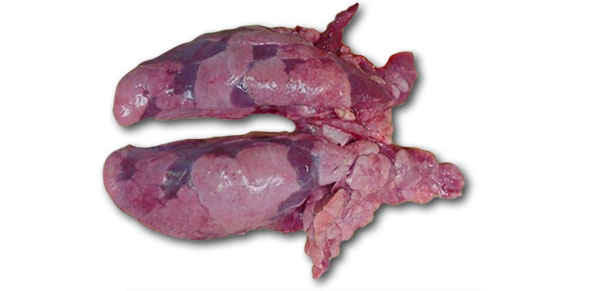
Lungs of the necropsied 10-week-old piglet
In response to the influenza outbreak, we decided to vaccinate all the sows two times 3 weeks apart with a new trivalent vaccine (H1N1, H1N2, H3N2) and treat the affected pigs with aspirin or paracetamol.
Evolution of the clinical case

Mass vaccination against influenza was implemented in August 2010. Serological analysis performed in piglets showed a good passive transfer of maternal antibodies against SIV from the vaccinated sows.
However, a severe syndrome with various clinical signs occurred in November: no more coughing in sows but neonatal diarrhoea, and streptococcosis, colibacillosis and coughing in the fattening pigs born from non-vaccinated sows.
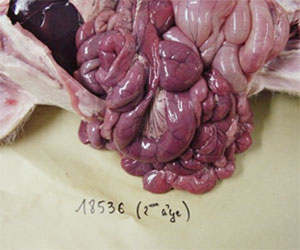 |
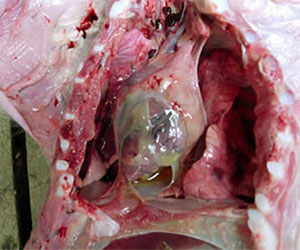 |
| Small intestine of a piglet with colibacillosis |
Pericarditis linked to streptococcal infection |
In November 2010, additional lab investigations showed a co-circulation of PRRSV (Figure 1) and Mycoplasma hyopneumoniae (Figure 2) in the fattening pigs.
Figure 1: Results of Idexx PRRS serologies in November 2010.
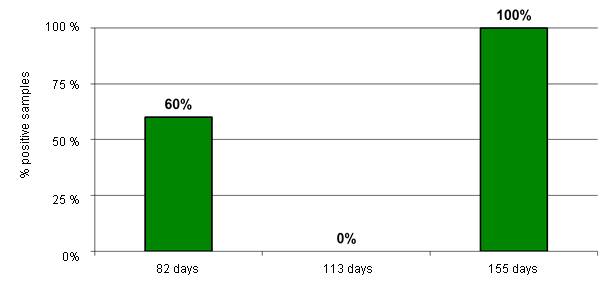
Figure 2: Results of Idexx Mhyo serologies in November 2010.
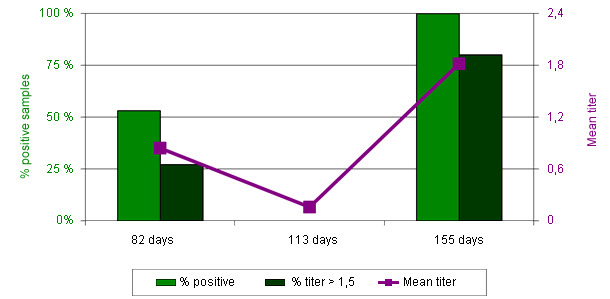
A strong destabilization of the herd due to the PRRS and the Mhyo was evident.
We decided, along with the the farmer, to:
- Re-vaccinate twice with a MLV PRRSv vaccine all the sow herd and the gilts (3 weeks between the 2 injections)
- Treatment of gilts with macrolids (against the mycoplasma infection) before entering the sow herd in order to avoid the circulation of Mhyo in the sows (we had no clinical signs in the sows at that time)
- Improvement of internal biosecurity
- Serological follow-up of piglets born to sows vaccinated against influenza and PRRS
In Figure 3, we can see the evolution of the serological titers (measured with influenza ELISA) in the piglets born to the first batch of sows vaccinated with the trivalent influenza vaccine. No more circulation of influenza could be detected in these piglets.

Figure 3: Evolution of the ELISA titres (Influenza Abs) in ten piglets born to vaccinated sows
In this figure, it is interesting to notice that the first 5 piglets (901 to 905) were born to gilts and the other 5 were born to older sows: the titres are quite lower in these first 5 piglets compared to others.However, no recirculation of influenza occurred during the growing period of these animals.
The economical impact of the influenza outbreak, in the first place, and the PRRSv and the Mhyo co-circulation after, has been strong, as it can be seen in Tables 3 and 4 (compare them to the results in Tables 1 and 2 before the outbreak).
Table 3: Technical results in the breeding herd (after the outbreak) in comparison to the reference results in Brittany.
| Herd 2011 | Top 10% in Brittany | |
| Weaned/sow/year | 27,2 | 31,6 |
| Total born | 14,2 | 14,7 |
| Weaned/litter | 11,05 | 12,3 |
| losses/born alive | 14,8 % | 10,6 % |
| born dead | 6 % | 6,1 % |
| Conception rate | 89,1 % | 93,2 % |
Table 4: Technical results in the growing pigs (after the outbreak) compared to reference results of Brittany.
| Herd 2011 | Top 10% in Brittany | |
| Pigs produced/sow | 23 | 24,7 |
| Global FC ratio | 2,74 | 2,8 |
| Wean to slaugther losses | 6,9 % | 5 % |
| Daily gain 30-115 kg | 755 g | 796 g |
Comments
This field report illustrates the consequences of an outbreak of SIV in a farrow-to-finish farm: destabilization of the health status of the herd, and favoring of the co-circulation of PRRSV and Mycoplasma hyopneumoniae inducing a severe drop of the technical-financial parameters over a full year.
In July 2011, we performed serologies for PRRSv and Mycoplasma hyopneumoniae and all the samples were negative as before the outbreak.





